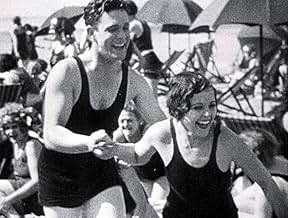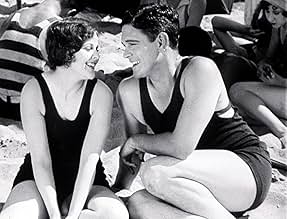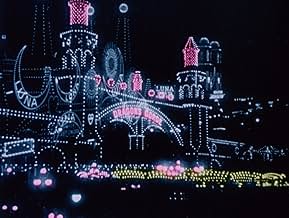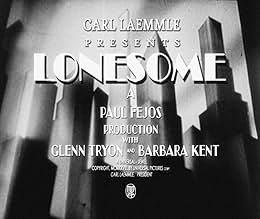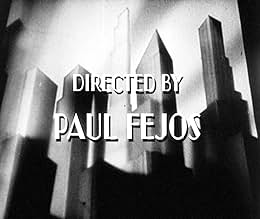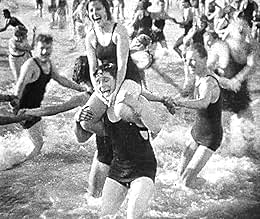CALIFICACIÓN DE IMDb
7.7/10
2.8 k
TU CALIFICACIÓN
Agrega una trama en tu idiomaTwo lonely people in the big city meet and enjoy the thrills of an amusement park, only to lose each other in the crowd after spending a great day together. Will they ever see each other aga... Leer todoTwo lonely people in the big city meet and enjoy the thrills of an amusement park, only to lose each other in the crowd after spending a great day together. Will they ever see each other again?Two lonely people in the big city meet and enjoy the thrills of an amusement park, only to lose each other in the crowd after spending a great day together. Will they ever see each other again?
- Dirección
- Guionistas
- Elenco
- Premios
- 1 premio ganado en total
Gusztáv Pártos
- Romantic Gentleman
- (as Gustav Partos)
Henry Armetta
- Ferris wheel guy
- (sin créditos)
Edgar Dearing
- Cop
- (sin créditos)
Louise Emmons
- Telephone Caller
- (sin créditos)
Fred Esmelton
- Swami
- (sin créditos)
Jack Raymond
- Barker
- (sin créditos)
Churchill Ross
- Telephone Caller
- (sin créditos)
Opiniones destacadas
A sister of Sunrise and The Crowd, this film is more emotional and poetic than those landmarks and every bit as great. The plot concerns two working class American types, he works in the factory, she works on the intercom who meet by chance on a fairground and fall in love and then lose each other without knowing where the other lives.
The film's beginning is to be treasured, it follows in detail the morning ritual of first the girl and then the man in their respective homes. The effect conveyed is the organization and elegance of women over the tardy, rushed, half-baked activities of men. The love story between the two characters is so beautifully etched and played so naturalistically by the actors(Barbara Kent and Glenn Tryon) that the sense of loss in the latter half of the film is all the more painful and heart-breaking. The film deals with a certain truth about living in a city that has remained constant even after a good 80 years. At once a constant sense of community and at other an equally constant sense of loneliness from being in a crowd.
The film's beginning is to be treasured, it follows in detail the morning ritual of first the girl and then the man in their respective homes. The effect conveyed is the organization and elegance of women over the tardy, rushed, half-baked activities of men. The love story between the two characters is so beautifully etched and played so naturalistically by the actors(Barbara Kent and Glenn Tryon) that the sense of loss in the latter half of the film is all the more painful and heart-breaking. The film deals with a certain truth about living in a city that has remained constant even after a good 80 years. At once a constant sense of community and at other an equally constant sense of loneliness from being in a crowd.
...that I cannot stand my own company...says the hero.
This could be the optimistic side of King Vidor's "the crowd".This era was a time when the pursuit of happiness was legitimate and "even with a face like that" you could hope to find the woman of your dreams.Robert Siodmak would make "Menschen Am Sonntag" and Marcel Carné "Nogent Eldorado Du Dimanche" soon after ,and would replace Coney Island by the banks of the Rhine or of the Seine.
1928 was the year before the crash .Even in the biggest city in the world ,you can be lonelier than the loneliest of creatures.He pretends he is a millionaire ,she pretends she is a princess ;in fact he is a working man,she is an operator .
It is not as optimistic as it seems at first sight.The crowds are hostile and do nothing to help them ,they are as selfish as today's crowds .
"Lonesome " is an important movie,if only for its simplicity and its spontaneity.Everything happens in the short space of one day (from the rude awakening to the night when solitude becomes even harder to bear ) and the two principals are really endearing ,almost matching Janet Gaynor and Charles Farrell.
NB:Paul Fejos would continue his career in France in the early thirties where he directed Annabella in a tragic melodrama ("Marie Legende Hongroise")and a remake of Feuillade's "Fantomas", the first third of which surpasses the original .
This could be the optimistic side of King Vidor's "the crowd".This era was a time when the pursuit of happiness was legitimate and "even with a face like that" you could hope to find the woman of your dreams.Robert Siodmak would make "Menschen Am Sonntag" and Marcel Carné "Nogent Eldorado Du Dimanche" soon after ,and would replace Coney Island by the banks of the Rhine or of the Seine.
1928 was the year before the crash .Even in the biggest city in the world ,you can be lonelier than the loneliest of creatures.He pretends he is a millionaire ,she pretends she is a princess ;in fact he is a working man,she is an operator .
It is not as optimistic as it seems at first sight.The crowds are hostile and do nothing to help them ,they are as selfish as today's crowds .
"Lonesome " is an important movie,if only for its simplicity and its spontaneity.Everything happens in the short space of one day (from the rude awakening to the night when solitude becomes even harder to bear ) and the two principals are really endearing ,almost matching Janet Gaynor and Charles Farrell.
NB:Paul Fejos would continue his career in France in the early thirties where he directed Annabella in a tragic melodrama ("Marie Legende Hongroise")and a remake of Feuillade's "Fantomas", the first third of which surpasses the original .
10Varlaam
This film is outstanding.
A man and woman leave their respective rented rooms for work. He's a "punch presser"; she's a switchboard operator. After work, neither one feels up to joining friends; they just feel too ... single. But they both head to Coney Island. They meet, fall in love, get separated, return home distressed. A plot that simple, even clichéd, does not appear to hold much promise.
But the energy! The pacing is so frenetic. There's constant movement on camera, clocks ticking, crowds scurrying, throngs crushing, machines stamping, carnivals, streamers, roller coaster rides. Moments of relative calm come when the lovers are together.
The thrilling impersonality of the urban maelstrom has hardly been better depicted. I came away thinking it was one of the best things I've seen.
If you've seen "The Devil and Miss Jones", the Jean Arthur / Robert Cummings comedy from 1941, then you can't help but remember the Coney Island beach scene where everyone is packed in together with barely room to move.
Well, this film has a scene just like that one. In fact, the greater part of the film is that way. You're never so alone as when you're in a crowd. These scenes are funny, but they do make their point.
I saw a restored print of "Solitude" (as it was titled) with colour tinting and three sound sequences, courtesy of Cinematheque Ontario. The sound segments are just awful, so typical of the very earliest sound, but perhaps they're a blessing in disguise. The extraordinary quality of the silent film is spotlighted by the awkwardness of these three brief scenes: Jim and Mary on the beach, Jim and Mary near the midway, Jim at the police station.
The ultimate restoration of this elusive marvel would make the film silent throughout, liberating it from the stylistic cacophony of the stilted sound sequences.
Neither lead performer, Barbara Kent nor Glenn Tryon, was known to me previously. (Andy Devine is plainly recognizable however.) It seems that Tryon later became the producer of "Hellzapoppin" and "Hold That Ghost". He also holds the only acting credit for a film that anyone at all seems to have seen, "Variety Girl" from 1947. To me, Barbara Kent resembles Paulette Goddard somewhat, while Glenn Tryon looks like a brother to Don DeFore and Bob Cummings.
The screening I attended was the Toronto première of the restoration. Let's hope it now becomes more widely available.
A man and woman leave their respective rented rooms for work. He's a "punch presser"; she's a switchboard operator. After work, neither one feels up to joining friends; they just feel too ... single. But they both head to Coney Island. They meet, fall in love, get separated, return home distressed. A plot that simple, even clichéd, does not appear to hold much promise.
But the energy! The pacing is so frenetic. There's constant movement on camera, clocks ticking, crowds scurrying, throngs crushing, machines stamping, carnivals, streamers, roller coaster rides. Moments of relative calm come when the lovers are together.
The thrilling impersonality of the urban maelstrom has hardly been better depicted. I came away thinking it was one of the best things I've seen.
If you've seen "The Devil and Miss Jones", the Jean Arthur / Robert Cummings comedy from 1941, then you can't help but remember the Coney Island beach scene where everyone is packed in together with barely room to move.
Well, this film has a scene just like that one. In fact, the greater part of the film is that way. You're never so alone as when you're in a crowd. These scenes are funny, but they do make their point.
I saw a restored print of "Solitude" (as it was titled) with colour tinting and three sound sequences, courtesy of Cinematheque Ontario. The sound segments are just awful, so typical of the very earliest sound, but perhaps they're a blessing in disguise. The extraordinary quality of the silent film is spotlighted by the awkwardness of these three brief scenes: Jim and Mary on the beach, Jim and Mary near the midway, Jim at the police station.
The ultimate restoration of this elusive marvel would make the film silent throughout, liberating it from the stylistic cacophony of the stilted sound sequences.
Neither lead performer, Barbara Kent nor Glenn Tryon, was known to me previously. (Andy Devine is plainly recognizable however.) It seems that Tryon later became the producer of "Hellzapoppin" and "Hold That Ghost". He also holds the only acting credit for a film that anyone at all seems to have seen, "Variety Girl" from 1947. To me, Barbara Kent resembles Paulette Goddard somewhat, while Glenn Tryon looks like a brother to Don DeFore and Bob Cummings.
The screening I attended was the Toronto première of the restoration. Let's hope it now becomes more widely available.
... and I could say the same thing about Fejos' "Broadway", made a year later. Fejos recounts the tale of two lonely New Yorkers, Jim (Glen Tryon) and Mary (Barbara Kent), who find love and each other during a half day holiday at the beach and Coney Island. You first see the workday from Jim and Mary's perspective as they are ruled first by the tyranny of the alarm clock and then the tedium of the workday as you see a clock overlaying the image of each at work. Jim is a low-level machine operator, and Mary is a telephone operator. Then there are "the crowds". Jim and Mary are crowded at breakfast, at a diner filled with patrons, crowded on the subway, crowded at work, and crowded at the beach and amusement park. Yet both of them are completely alone in the world, which, especially in the attractive Miss Kent's case, seems somewhat inconceivable.
This late era silent has a dearth of title cards, which does not subtract from the film's enjoyment. In fact, what does subtract just a little are the short dialogue scenes that just don't make sense. One scene is Jim and Mary on the beach suddenly in the dark AND in color, with the crowd removed. Nothing they say shines any light on their situation or feelings at all. Another one is in a courtroom where Jim has been detained for being unruly. He gives a speech like a Bolshevik basically shaming the judge and ... the judge lets him go???? This social awareness seems very strange stuff coming from Jim who, up to that point, has seemed to be a very uncomplicated fellow. Very strange, but typical of talking scenes inserted into silent films at the dawn of sound.
What is extra special about this film is to see the lives of working class people in 1928. Notice that the workday that Jim and Mary are going through is a Saturday, and this was the norm back then and until some time after WWII. People would normally work half a day on Saturday and have only Sunday in its entirety as a day off. Catch this film if you can, even if you are not a huge silent film buff.
This late era silent has a dearth of title cards, which does not subtract from the film's enjoyment. In fact, what does subtract just a little are the short dialogue scenes that just don't make sense. One scene is Jim and Mary on the beach suddenly in the dark AND in color, with the crowd removed. Nothing they say shines any light on their situation or feelings at all. Another one is in a courtroom where Jim has been detained for being unruly. He gives a speech like a Bolshevik basically shaming the judge and ... the judge lets him go???? This social awareness seems very strange stuff coming from Jim who, up to that point, has seemed to be a very uncomplicated fellow. Very strange, but typical of talking scenes inserted into silent films at the dawn of sound.
What is extra special about this film is to see the lives of working class people in 1928. Notice that the workday that Jim and Mary are going through is a Saturday, and this was the norm back then and until some time after WWII. People would normally work half a day on Saturday and have only Sunday in its entirety as a day off. Catch this film if you can, even if you are not a huge silent film buff.
10clanciai
The striking character of this film is its extreme intensity in a fantastic camera work that keeps rushing on in breathless frenzy to the very bitter end of the film. It's almost like a documentary in its constant flow of following the crowds from the working places to the reckless carneval of Coney Island, never leaving the strenuous hard pace of life for one second, except for the moments when the lovers find each other. Then there is a touch of poetry, which also marks the film with a totally different character, which makes it doubly interesting. This film is like no other film, the closest in likeness is actually Eisenstein's "Battleship Potemkin" which also wallows in following the crowds in wild frenzy, but here the lovers provide some privacy and individualism, which is totally missing in Eisenstein's masterpiece, and this is certainly a masterpiece of the same rank but on a different level, for its very human touch of simplicity and basic togetherness. There are also some resemblance to Fritz Lang's "Liliom" with Charles Boyer, which also renders the carneval and wild pleasure hunting in frenzied rush of popular festivity in unforgettable cinematography.
Paul Fejos made many documentaries, he was a master and genius in observing and capturing life at its most original and basic level, his documentaries are from Madagascar, South East Asia, Peru apart from Europe and America, he made altogether 44 films, and this is just an example of his extremely personal and highly advanced art of the film.
Paul Fejos made many documentaries, he was a master and genius in observing and capturing life at its most original and basic level, his documentaries are from Madagascar, South East Asia, Peru apart from Europe and America, he made altogether 44 films, and this is just an example of his extremely personal and highly advanced art of the film.
¿Sabías que…?
- TriviaIt was one of the first motion pictures to have sound and a couple of talking scenes. It was released in both silent and monaural versions. Some scenes in existing original prints of the film are colored with stencils.
- Versiones alternativasProduced in both sound and silent versions. The sound version was 6,785 feet in length, and the silent version was 6,193 feet.
- ConexionesFeatured in Fejezetek a film történetéböl: Az amerikai film kezdetei (1989)
- Bandas sonorasAlways
(uncredited)
Written by Irving Berlin
[Played by dance orchestra at ballroom]
Sung by Nick Lucas
[on Brunswick recording played in last scene]
Selecciones populares
Inicia sesión para calificar y agrega a la lista de videos para obtener recomendaciones personalizadas
- How long is Lonesome?Con tecnología de Alexa
Detalles
- Tiempo de ejecución
- 1h 9min(69 min)
- Mezcla de sonido
- Relación de aspecto
- 1.19:1
Contribuir a esta página
Sugiere una edición o agrega el contenido que falta



